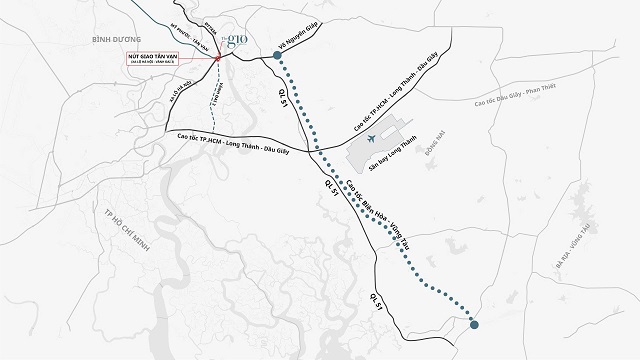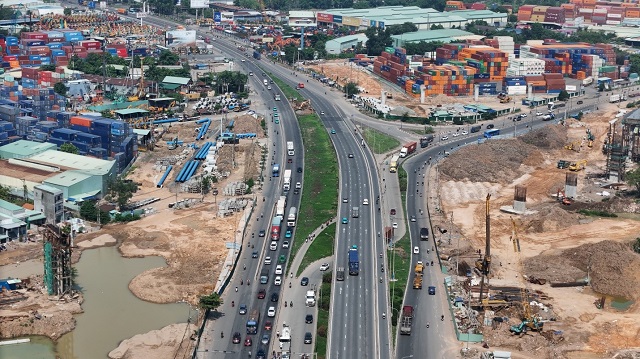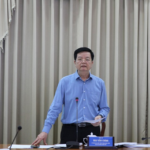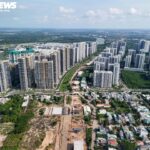Services
Redefining Inter-Regional Transport Structure
According to surveys, the Tan Van interchange is over 85% complete. In parallel, the Ring Road 3 project, which commenced construction in mid-2023, is also accelerating progress in Ho Chi Minh City and Dong Nai, aiming for technical passage by the end of the year.

Tan Van Interchange, Bien Hoa – Vung Tau Expressway
|
The Bien Hoa – Vung Tau Expressway, the main connector between Ho Chi Minh City and Thi Vai – Cai Mep port cluster, is also expediting the implementation of phase 1, with completion expected in Q4 2025. Simultaneously, the Long Thanh International Airport’s phase 1, with a capacity of 25 million passengers annually, will undergo technical operations, significantly boosting regional infrastructure and the local real estate market.
Experts opine that rarely have so many large-scale infrastructure projects converged towards completion simultaneously. This not only fulfills the need for infrastructure upgrades but also signifies a significant shift in planning paradigms, from a linear model adhering to old transport routes to a multi-centric and multi-dimensional urban structure.
In reality, over the past decade, Ho Chi Minh City’s eastern region and its vicinity have predominantly expanded along the Hanoi Highway and the Ho Chi Minh City – Long Thanh – Dau Giay Expressway. Population, industrial, logistics, and real estate investment flows have concentrated around these two corridors, resulting in congestion and dependence on a handful of vital routes.

Current Status of Tan Van Interchange (Hanoi Highway – Ring Road 3)
|
However, with the concurrent formation of the Tan Van Interchange, Ring Road 3, Bien Hoa – Vung Tau Expressway, and Long Thanh International Airport, the regional transport structure is undergoing a complete transformation.
Instead of developing centripetally towards Ho Chi Minh City’s center, the eastern region can now connect in multiple directions to ports, airports, industrial parks, and large urban areas. Simultaneously, it opens up an entirely new development space, where buffer zones like Bien Hoa and Tan Van are elevated into independent growth axes, capable of forming large-scale urban, commercial, service, and logistics centers without relying on Ho Chi Minh City’s “core.”
For the real estate sector, this foundation is crucial for stable growth, as asset values are no longer solely dependent on proximity to the center but on connectivity and long-term operational efficiency. Areas located at the “intersection” of transport infrastructure, rather than merely alongside a single corridor, will become investment and residential hotspots in the coming period.
The Gió Riverside Seizes a Significant Opportunity
According to analysts, the synergy of these four critical infrastructures marks a turning point for the region bordering Ho Chi Minh City, Dong Nai, and Binh Duong.
The Tan Van Interchange plays a central role as the junction of Hanoi Highway, Ring Road 3, and multiple major routes into Ho Chi Minh City. When the Ring Road 3 and Bien Hoa – Vung Tau Expressway become operational, the entire transport system in the eastern region will be reshaped, unveiling new development prospects for urban and real estate sectors.
 The Gió Riverside Project Perspective
|
Developed by An Gia, The Gió Riverside is a rare project adjacent to the Tan Van Interchange, Hanoi Highway, and Ring Road 3. From the project, residents are just a 10-minute drive from the Bien Hoa – Vung Tau Expressway, 20 minutes from Long Thanh International Airport, and 70 minutes from Vung Tau City.
Its presence at the connection heart bestows upon the project substantial practical value advantages. When the new roads are operational, travel time will be significantly reduced, spurring regional economic development, and The Gió Riverside’s location will become an inter-regional hub for not only transportation but also capital and high-quality population migration.
On the other hand, the location advantage also enables The Gió Riverside to fulfill its potential for value appreciation. While many other projects are merely adjacent to a single infrastructure route and relatively far from intersection points, The Gió Riverside, situated at the gateway to this extensive connectivity network, ensures more stable growth potential in the medium and long term.
Notably, as the market enters a phase of restructuring, investors and owner-occupiers prioritize products with high utility value, linked to tangible infrastructure. The Gió Riverside not only satisfies these criteria but also captures the “sweet spot” in the eastern region’s infrastructure development cycle, poised to capitalize on future price appreciation potential.
Visit https://www.thegio.vn/ for project details.
– 08:00 09/06/2025
Aspiring for a Technical Breakthrough: Aiming to Complete the Construction of HCMC Ring Road 3 by the End of 2025
The government aims to technically open Ho Chi Minh City’s Ring Road 3 by December 2025. This comes after making significant progress in addressing obstacles and accelerating construction on the four component projects that make up this vital road route.
The Ministry of Construction: 2,800km of Highways to be Completed by September 2025
As of September 2025, Vietnam will have completed a remarkable 2,800 kilometers of expressway, according to Minister of Construction Tran Hong Minh. This impressive feat of engineering is a testament to the country’s dedication to improving its infrastructure and connectivity. With this extensive network of high-speed roads, Vietnam is poised to boost its economy and facilitate seamless travel and trade across its vast landscape.
The Sky’s the Limit: 55 Pitt Street, Sydney – BM Windows’ New Venture Soars High After The One Toronto Triumph
The swift transition from an iconic North American project to a cutting-edge green venture in Australia showcases the formidable momentum of BM Windows, Vietnam’s premier aluminum and glass curtain wall enterprise. This company has proven its mettle in the most technically demanding projects globally.





















